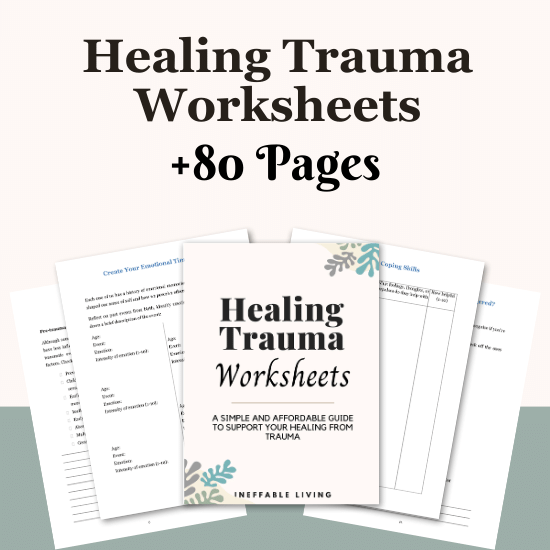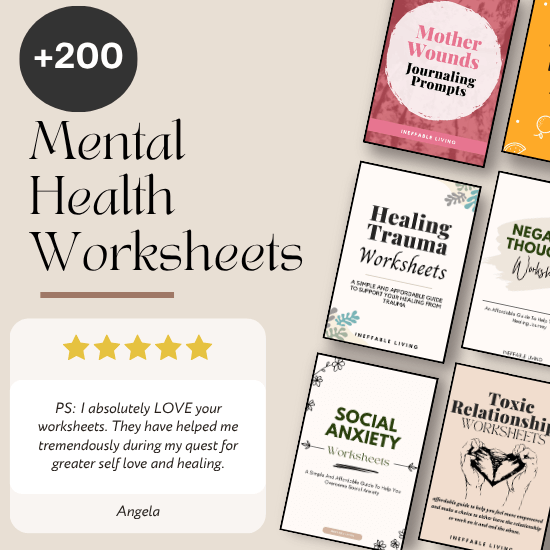Today, you’re going to learn all about Tension and Trauma Release Exercises (TRE) and discover 7 trauma release exercises to support your recovery after trauma.
How Does The Body Handle Trauma?
Stressful and traumatic events are usually based on threats to life, be they real or perceived.
As a result, the fight, flight, or freeze response is activated as a basic response to survival, which also involves activation of the somatic musculature and the autonomic nervous system.
This shows how the body can be intimately involved into survival response that is linked to stressful or traumatic events.
In fact, research shows that threatening situations cause the body the draw inward to protect the front of the neck, chest, and abdomen, in a way that resembles the position of the fetus, which is the safest position of the human body.
Related: Why Is Trauma Therapy So Hard? (+Best Trauma Healing Exercises To Support Your Recovery)
What is Trauma Release Exercises (TRE)?
Tension and Trauma Release Exercises (TRE) are an innovative set of exercises that help the body release deeply held tension and trauma.
TRE was created by psychologist Dr. David Berceli, who had discovered that by inducing the body’s natural tremoring mechanism, communities in the Middle East and Africa that had been traumatized by war had less need for psychotherapy or drugs to control post-traumatic stress disorder (PTSD).
How TRE Works?
TRE activates the natural reflex mechanism of shaking or vibrating that releases muscular tension and helps calm down the nervous system, which helps the body return back to a state of balance.
TRE could be practiced in a group or alone.
Related: How to Practice Self-Brainspotting Safely?
7 Trauma Release Exercises To Support Your Recovery
TRE comprises seven simple exercises that can be modified to suit people with medical conditions.
Note
The following exercises have been proved to be a safe, self-administered program, in cases of stress, tension, and post-trauma symptoms.
If you have a history of physical injuries, consult your healthcare provider before using these exercises.
Also, note that these exercises are not alone sufficient for recovering from trauma. If you suffer from PTSD or CPTSD, you may require the guidance of a mental health professional
Exercise 1 (Stretching the ankles)
1. Spread your legs shoulder’s width apart.
2. Sway to one side by rolling onto the sides of your feeling. You should be standing on the outside of one foot and on the inside of the other foot. Hold this position for a few seconds and then sway to the other side.
3. Continue slowly swaying back and forth for about 5 to 8 times in each direction.
4. Once done, shake out your feet.
Exercise 2 (Stretching the calf muscle)
1. Place one foot in front of you and put all your weight onto that foot. Keep the back leg on the floor just for balance.
2. Lift the front heel off the ground as high as you feel is comfortable and go up and down on your toes. Repeat for about 5 to 8 times.
3. Once finished, shake the leg you just exercised.
4. Repeat the same with the other foot.
Exercise 3 (Stretching the upper legs)
1. Place one leg in front of the other.
2. Lower your hips slightly as if you are about to sit on a chair. This will cause the knee of your front leg to bend. Do not let it bend beyond the length of the foot. Keep bending and straightening your standing knee for about 5 to 10 times.
3. Once finished, shake the exercised leg.
4. Switch to the other leg and repeat the same.
Exercise 4 (Stretching your inner legs, hips, and back)
1. Stand with your legs spread a comfortable width apart.
1. Fold forward, bending the knees. You may not put your hands on the ground if that is too difficult.
2. With your hands in the center, take 3 deep breaths and relax by allowing gravity to naturally stretch your body.
3. Then slowly walk your hands to one foot. Hang onto the leg or the floor and hold this position for three slow, deep breaths.
4. Go over to the other foot. Hold this position for three deep breaths.
5. Move your hands back to the center and reach between your legs behind you. Hold this position for three deep breaths.
6. Once finished, go back to standing position and place your hands for support as you stand.
Exercise 5 (stretching the front of the body)
1. Place your feet beyond hip-width apart.
2. Place your hands partly on the lower back. You can look down or up.
3. Bend your knees slightly and bow your back slightly as you move your hips forward.
4. Gently rotate to one side, looking behind and keeping the bowed position. Take three deep breaths.
5. Come center and rotate in the opposite direction. Take three deep breaths.
6. Return to the center position. Take three deep breaths and come standing in a normal position.
Exercise 6 (Wall sit exercise/stretching upper leg muscles)
1. Sit with your back against the wall as though you were sitting on a chair, feet a comfortable distance apart.
2. Once it becomes slightly uncomfortable, move up the wall about an inch or two.
3. Again if this becomes too uncomfortable, move up the wall about an inch or two. The goal is to allow your legs to tremor/shake without pain.
4. After about 3 to 5 minutes, push off the wall to a standing position.
5. Bend your knees slightly and allow yourself to hang forward. It is normal for the body to start shaking in this position. Touch the ground with your hands and stay there for a minute if possible.
Exercise 7 (Floor sequence)
1 Lay on the floor and bend your knees.
2. Open the knees wide in a rest position with your foot soles touching and the heels close to your body.
3. From that position, lift your hips off the ground for 30 seconds to one minute.
4. Gently set your hips down on the ground and let your knees relax for a minute.
5. Slightly close your knees about an inch or two and hold this position for two minutes. It is normal for you to experience tremoring/shaking in this position. If it gets uncomfortable stop by stretching the legs out and pulling the toes back.
When you’re done or if you needed a break, try walking around or sitting down and breathing in a relaxed manner.
TRE Providers Directories
Benefits of Trauma Release Exercises
Trauma Release Exercises (TRE) are a simple and effective approach to relieve the symptoms of trauma and stress. Some benefits of TRE include:
1. Reduce tension and stress: TRE is designed to help release the buildup of tension that typically accumulates in the body as a result of stressful or traumatic events. As these tensions get released, you will feel more relaxed and less stressed.
2. Improve physical well-being: TRE can help improve blood circulation, reduce pain, promote better sleep and digestion, and strengthen your immune system.
3. Enhance emotional well-being: TRE can help alleviate anxiety, depression, and other emotional issues that may arise from trauma or stress.
4. Increase self-awareness: TRE provides a way to become more aware of your body and its sensations, helping you to better understand and manage your emotions and well-being.
5. Empowerment: By learning how to activate and facilitate your body’s natural healing processes, you become empowered to take charge of your own healing journey.
Overall, TRE offers many benefits for those dealing with trauma and stress, helping them to restore balance and ease in their bodies and minds.
Healing Trauma Worksheets

Frequently Asked Questions about TRE
1. Can TRE be done alone?
Yes, TRE (Tension and Trauma Releasing Exercises) can be done alone once you have learned the technique from a certified TRE provider or through an online course.
However, it is important to note that in certain instances, it may be helpful to work with a trained professional in a therapeutic setting, especially if you are dealing with complex trauma.
This can ensure that you are using the technique effectively and safely, and that any emotional or physical reactions are properly supported.
Related: How To Expand Window Of Tolerance? (+FREE Window of Tolerance PDF)
2. Can TRE be done by anyone?
TRE (Tension and Trauma Releasing Exercises) can be done by most people, however, it is always recommended to consult with a healthcare professional before beginning any new exercise or therapeutic program.
TRE is generally safe for people of all ages and fitness levels, but should be modified or avoided altogether for people with certain physical or mental health conditions.
It’s always important to listen to your body and follow the guidance of a trained TRE provider.
3. Can TRE be harmful?
There are certain situations when it may be best to avoid practicing Trauma Release Exercises (TRE):
1. If you have a history of seizures or epilepsy, it is important to consult with your doctor before attempting TRE.
2. If you have a herniated disk or other serious back injury, you should not attempt TRE without first consulting with a medical professional.
3. If you are experiencing acute pain or discomfort, or have recently undergone surgery or a major medical procedure, it is recommended to wait until you have fully recovered before attempting TRE.
4. If you are pregnant or have recently given birth, it is best to avoid TRE until after childbirth and until you have fully recovered.
5. If you have a history of serious mental health conditions such as schizophrenia or bipolar disorder, you should avoid TRE without consulting with a mental health professional.
Overall, it is always recommended to consult with a medical professional before attempting any new exercise or wellness program, especially if you have any preexisting medical conditions.
Related: Do I Have Trauma? Top 4 Practical Exercises To Support Your Trauma Healing
4. Can TRE be done with other therapy?
Yes, TRE (Tension and Trauma Releasing Exercises) can be done in combination with other therapies.
In fact, TRE is often used as a complementary therapy with other forms of psychotherapy, such as talk therapy or cognitive behavioral therapy.
It can also be used in conjunction with physical therapies like yoga or massage.
The goal of combining TRE with other therapies is to achieve a deeper sense of relaxation, release tension, and promote healing both physically and emotionally.
However, it’s important to discuss with your healthcare provider or therapist before implementing TRE or any new therapy into your treatment plan.
Related: Top 13 Signs You Are Healing From Trauma (& How To Build Emotional Resilience)
5. How do I know if TRE is right for me?
TRE (Trauma Release Exercises) can be beneficial for many people, but it is important to consider your individual needs and circumstances when deciding if it is right for you.
Here are a few things to consider:
Understanding TRE: It is important to have a good understanding of what TRE is and how it works. TRE is a body-based practice that uses gentle exercises to activate tremors in the body, which help to release tension and stress stored in the muscles and nervous system. If you are comfortable with this approach and feel it could be helpful for you, then TRE may be right for you.
Trauma history: TRE was originally developed to assist individuals who have experienced trauma, but it can be beneficial for anyone experiencing stress or tension in their body. If you have experienced trauma or have ongoing stress in your life, TRE may be helpful for you.
Physical limitations: TRE involves gentle physical movement, so it is important to consider any physical limitations you may have before trying it. If you have any concerns, it is always best to consult with a healthcare professional before starting TRE.
Personal goals: Consider what your personal goals are and whether TRE aligns with them. For example, if you are seeking relief from stress or tension in your body, then TRE may be a good fit for you.
It is important to listen to your own instincts and seek guidance from a healthcare professional if you have any concerns.
Related: How to Practice Self-Brainspotting Safely?
6. Do Trauma Release Exercises Work?
Trauma Release Exercises, or TRE, can be helpful for some people in releasing tension and stress from the body that has been stored as a result of trauma.
However, it is important to note that the efficacy of TRE varies from person to person.
Some may find TRE to be a helpful addition to their overall healing process, while others may not experience significant relief from this technique alone.
It’s always important to work with a qualified healthcare professional or therapist when addressing trauma and its effects on the body and mind.
They can help you determine if TRE is a good fit for you and guide you through the process.
Related: Brainspotting Vs EMDR (Which One Is More Effective?)

References
- Portions of this article were adapted from the book Shake It Off Naturally, © 2015 by David Berceli. All rights reserved.
- Tension, Stress and Trauma Release : TRE® (traumaprevention.com)
- Can Trauma and Tension Release (TRE) exercises really improve stress and PTSD? | Patient
- What Are Trauma Release Exercises (TRE) & Do They Work? | Glamour UK (glamourmagazine.co.uk)
- Effects of Self-induced Unclassified Therapeutic Tremors on Quality of Life Among Non-professional Caregivers: A Pilot Study – PMC (nih.gov)
- Case Report of a Former Soldier Using TRE (Tension/Trauma Releasing Exercises) For PostTraumatic Stress Disorder Self-Care – JMVH
- Tension and trauma releasing exercises for people with multiple sclerosis – An exploratory pilot study – ScienceDirect
- Neurogenic Tremors Training (TRE) for Stress and PTSD: A Controlled Clinical Trial (dtic.mil)
- Tension and Trauma Releasing Exercises (TRE) | Science-Based Medicine (sciencebasedmedicine.org)



